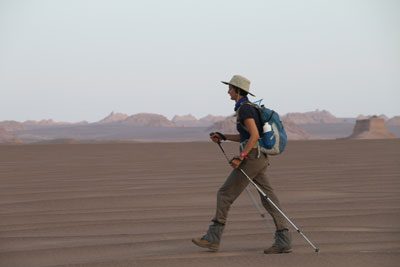Blisters are a fact of life on desert expeditions. Even those who ‘had never had one before’ or say ‘I never get blisters’ get them. The rough ground, hot temperatures and fine soft sand will stress your feet more than normal, so getting the right shoe for you is really important. This may be a full desert boot, a lightweight shoe or three-season walking boot. Expedition leader Dave Lucas outlines the most important points to consider when finding the perfect pair.
Fit
The most important aspect of your shoes is that they need to be comfortable, tried and tested but not so worn that they are on their last legs and may fall apart mid-trek. Feet come in all shapes and sizes so it’s worth taking the time to find out what will work for you specifically. Good footwear stores should offer measuring and fitting advice so allow plenty of time before your trek to try on several pairs and make sure your final choice is well bedded-in.
Cushioning
There will be times on an expedition when you will walk over rough, jagged and loose talus. This will be very sore for those people who are walking in shoes with little cushioning. This is often the case in technical approach shoes, which are better for scrambling than walking. Some shoes have the added advantage of a tough mid-sole or plate that helps with anti‐bruising when walking on uneven ground.
Keeping out the sand
Walking in gravel and soft sand means that often within a few steps your shoes are full of sand. Having a liner or gusset between the main body of the shoe and the tongue of the shoe means that it will be harder for debris to get in. This is a really important design feature for your shoes, although this is often only a feature on shoes that have a Goretex liner, without this you will have to stop more often to empty your shoes of sand.
Ankle support
If you have had problems with your ankles in the past then you should aim to have ankle support in your shoes. Even if you have not had any ankle issues previously, still try to get a mid-height boot as these will be better at keeping out the sand as well as offering better ankle protection.
Heavy vs. lightweight
The lighter the boot the more likely they are to fall apart, but the heavier they are the more tired your legs will become and the hotter your feet will be. A full-leather walking boot will be too heavy and are not needed, a fabric boot or shoe will be much better suited for a desert trek.
Goretex Liner
It may rain while out in the desert, but in general it will be dry so a Goretex liner to your boots isn’t needed. A Goretex (GTX) liner reduces the breathability of your boots and traps in sweat and moisture, this acts to soften the skin and make your feet more prone to blisters.
As mentioned earlier, you may find that a shoe with a liner between the tongue of the shoe and the main body has to be lined with GTX so you may decide that it is worth the compromise on breathability. If so, you will just have to change your socks more often during the day.
What socks?
Counter-intuitively, the best type of socks for this environment might well be wool. Wool as a material can hold up to ⅓ of its mass in moisture before it feels damp to the touch, making it excellent for keeping your feet as dry as possible, in addition wool is naturally antimicrobial so will smell a lot less than synthetic option.
Do not go for the lightest woollen socks that you can find. Over several expeditions, people who wore a mid-weight wool sock had fewer blisters. Your feet will get hotter, but changing your socks during a day of walking will fix the problem of walking in damp socks. Double-lined socks or ‘blister free’ toe socks? Don’t even go there. As with your boots, make sure you test your socks out before bringing them on an expedition.
What brand?
The brand is less important. But the shape of the mould (‘last’) used to make the shoes varies between brands, so if you know a certain brand of shoe works for you then try and stay within that brand. Altberg tick all the boxes… except having been tried and tested by you. If you do decide to go with them then make sure you have enough time to wear them in.

Dave Lucas has spent over 65 months on expeditions in more than 80 countries from Europe and Asia to Africa and Latin America. Spending several months each year with the Bedouin in Egypt’s Sinai desert, it’s fair to say he knows this terrain.
Post tags:












